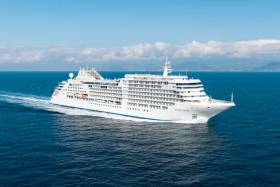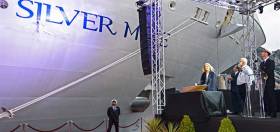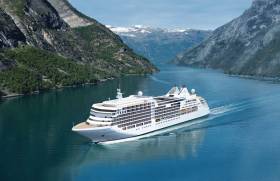Displaying items by tag: Silver Muse
Silver Muse Is Galway’s First Cruise Call Of 2018
#CruiseLiners - Galway’s first cruise call of 2018 is the Silver Muse currently anchored off Mutton Island, as Galway Bay FM reports.
The flagship of Silversea Cruises made her maiden Irish port of call off Dunmore East last September, just months after her launch in Monte Carlo.
Despite its more than 40,000 gross tonnage, the “ultra-luxury” Silver Muse accommodates a total of under 600 ‘guests’ and almost as many crew.
New Flagship: Silver Muse Makes Maiden 'Irish' Port of Call
#cruiseliners - A brand new flagship Silver Muse made her maiden 'Irish' port of call off Dunmore East, Co. Waterford today, writes Jehan Ashmore.
Silver Muse introduced into service this summer, had sailed overnight from Falmouth in the UK and anchored offshore of Dunmore East having embarked a pilot.
The maiden call is a coup for the Port of Waterford in a season that is drawing to a close. Only one more cruiseship is scheduled next week, when Nautica of Oceania Cruises calls but berthing to Belview Port.
Guests on board the 212m newbuild built in Italy, Fincantieri's yard in Genoa, are visiting the local attractions in a region that has also in recent times been marketed as Ireland's Ancient East.
As previously reported on Afloat, Silver Muse was christened at a lavish ceremony in Monte Carlo, Monaco, where owners Silversea Cruises have their headquarters.
The 40,700 gross tonnage ultra luxury cruiseship is the latest in Silverseas 9-strong fleet which operates at the high-end of the market. The newbuild is an evolution of their Silver Spirit class which elevates the luxury brand to new levels.
Accommodating just 596, the personalised service is to such a high level that there are nearly one crew member for every guest as they are referred as not passengers.
Among the facilities is an exclusive Zàgara Beauty Spa, casino, gym, a 327-seat theatre, eight dining venues and a swimming pool. In addition to offering guests the highest number of large suites in the Silversea fleet, and with the greatest number of connecting suites.
Tommorow it will be the turn of Cork Harbour to welcome the newcomer when Silver Muse is to berth not at Cobh but at the nearby Ringaskiddy deepwater berth. One of the reasons been is due to the call of the considerably larger Regal Princess, operated by Princess Cruises and accommodating around 3,500 passengers.
In season 2018, an example of an Irish based cruise sailing direct from Dubin takes place on 13 May, to Barcelona. The 13 day cruise is availavle with fares from €6,500 (per guest).
Silver Muse Christened in Monaco Before Venetian Society Cruise
#MonacoCeremony - Prince Albert II of Monaco attended Silversea Cruises christening ceremony of their new flagship Silver Muse in the principality, before a pre-inaugural cruise to Greece begins next week, writes Jehan Ashmore.
As previously reported, Afloat had identified Silver Muse is to make an Irish debut later this season with a call to Waterford (Dunmore East) in September. The 40,700 tonnes cruiseship with just 596 passengers are accommodated in ultra luxurious facilities and pampered by a crew total of 411. The newest cruiseship of the 9-strong Silversea fleet is also to be make a first call to Cork.
The Italian built cruiseship from Fincantieri's yard in Genoa, will operate at the top end of the market. Among the facilities is an exclusive Zàgara Beauty Spa, casino, gym, a 327-seat theatre, eight dining venues and a swimming pool. In addition to offering guests the highest number of large suites in the Silversea fleet, and with the greatest number of connecting suites.
At the red-carpet christening ceremony held last Wednesday at the outer pier of Port Hercule, the glamorous harbour of Monte Carlo saw Silver Muse officially named by Constanza Lefebvre. The daughter of Silversea chairman Manfredi Lefebvre d'Ovidio, was watched by dignitaries and invited guests during the traditional ship’s blessing and champagne bottle-breaking at the bow.
The newcomer is an exciting evolution of their Silver Spirit class and the location of Monaco was chosen for the ceremony as Silversea has its headquarters in Monte Carlo. At the quayside were performances by the Sinfonietta Orchestra of Rome and renowned violinist Charlie Siem.
Silver Muse is to depart from Villefranche neighbouring Nice next Wednesday (3 May) on a ‘Venetian Society Inaugural Cruise’.
Afloat has consulted that the 13-day cruise of Mediterranean gems among them Portofino, Amalfi, Santorini, Kusadasi in Turkay and end in Piraeus, the port for Athens. Fares for society members only are from €8,250 per person based in a Classic Veranda Suite on Deck 5/6.
#NewFlagship - Half of all cruiseship calls to visit Waterford Estuary are due in the first of a three-month season in which Afloat has identified to include a brand new cruiseship, writes Jehan Ashmore.
According to the cruiseship line-up for 2017, Afloat has noted that eight out of a total of 16 cruiseships are to visit the south-east region in the opening month of June. The leaves the balance of four cruiseships to call in August and equally the same number for the concluding month of September.
The Port of Waterford has terminals dotted on the estuary where 1,000 years ago Viking longboats headed upriver to firmly establish a trading port. This established Ireland's oldest city. In more recent centuries the city became world famous for its crystal making traditions. A popular tourist attraction as well as to the manor estate gardens on the environs of the city.
Brand New Cruiseship Call
As referred above Afloat has identified the call of a brand new cruiseship which is to be the Silver Muse, the flagship of Monaco based Silverseas Cruises. The 40,700 gross tonnage newbuild accommodates 596 guests in ultra-luxurious facilities. The newcomer is an exciting evolution of their Silver Spirit.
Afloat will have more to report on Silver Muse which will make a pre-inaugural voyage in home seas next month on a round trip voyage from Monte-Carlo of Mediterranean gems. Among them calls to quintessential destinations such as Barcelona, Palma and Portofino.
As for the first to caller to Waterford in early June is Artania. Pheonix Reissen, the German operators of the ship which would be more familiar to most as the original Royal Princess completed in 1984 for US based Princess Cruises. The 44,500 tonnes Artania with a 1,100 passenger capacity has been allocated an anchorage call off Dunmore East.
The predominant fishing harbour at the entrance to the estuary is where a further seven cruise callers will too be making an anchorage call.
Ultra luxury small-cruiseship Hebridean Sky of Noble Caledonia, is to call twice. Firstly calling in June at Belview, the main cargo (mostly lo-lo containers) terminal for the Port of Waterford.
On the second call in August, the diminutive sized ship is expected to head upriver to the city quays. The 4,200 tonnes ship is to berth along Frank Cassin Wharf, the former Bell Lines lo-lo terminal.
































































